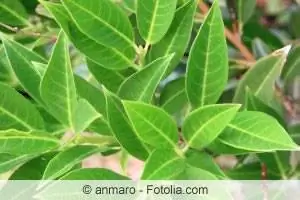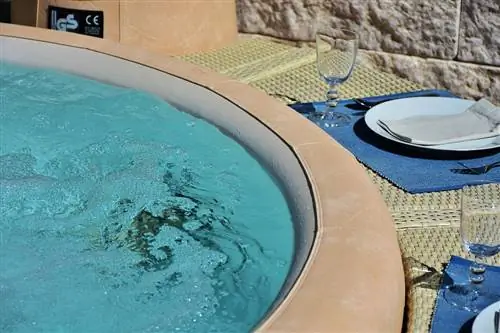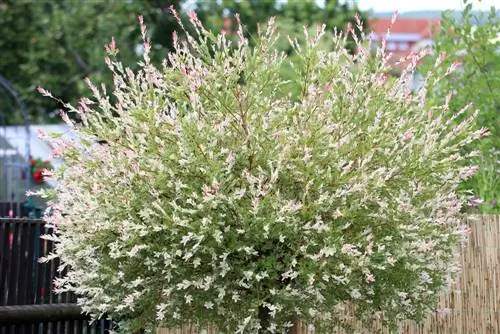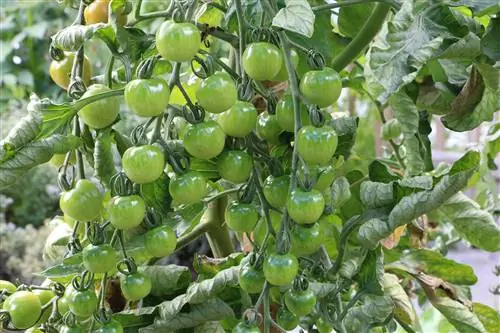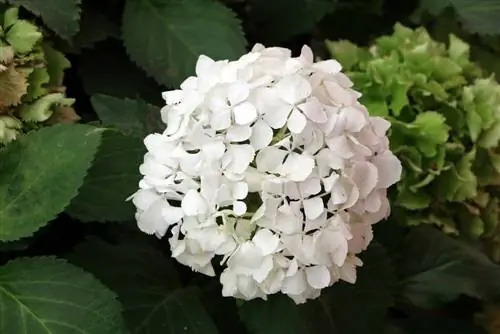- Author admin [email protected].
- Public 2023-12-17 03:39.
- Last modified 2025-01-24 12:45.
The laurel cherry, also known as cherry laurel, is often confused with the real laurel, but belongs to the rose family and is not related to the real laurel. Even though the elongated leaves of both plants are very similar. The plant, which originally comes from the Mediterranean region and Asia Minor, is very popular as a hedge plant.
General information about cherry laurel
This comparatively undemanding shrub plant can be wonderfully integrated into any garden. No matter whether it is an older, established garden or whether it is a new plant. Due to the sometimes very enormous growth, which depends on the variety of laurel cherry used, a fairly large garden is required for planting. Individual varieties can grow to a height of 7 m. Especially when it comes to hedge planting, the laurel cherry has the advantage over other hedge plants in that it grows comparatively quickly and is also evergreen. This means that we can enjoy their green leaves even in winter. The cherry laurel doesn't make any great demands when it comes to location either. However, the details of the location requirements will be discussed later. But the cherry laurel is not only great as a hedge plant, you can also find it again and again as a border to the terrace. However, it should be kept under control by regular pruning, as growth of approx. 40 cm per year is not uncommon for this plant. A cherry laurel also looks wonderful as a solitary plant, for example in the middle of a lawn. A large area can be easily broken up and divided into sections that are interesting to the eye. The design possibilities with the laurel cherry are almost unlimited. The cherry laurel also attracts attention with its pretty flowers that appear from April to June. The white flowers are clustered in clusters and have a very pleasant scent. The fruits of the cherry laurel are black and are processed into jam or dried fruit in Turkey, for example. However, if consumed raw, they develop hydrogen cyanide in the stomach and symptoms of poisoning can occur. Consuming all parts of the plant is not recommended.
Location
The laurel cherry can be planted almost anywhere in the garden. It only has problems in the deep shade of tall trees. As already mentioned, the cherry laurel is ideal as a hedge plant to separate it from the neighboring garden. It feels very comfortable in the company of rhododendrons, azaleas, ferns and ground cover plants, but also near conifers. The company with hosta, the so-called sweetheart lilies and the interaction with lily of the valley also makes the cherry laurel stand out. The demands on the soil are not particularly high. This should be moderately moist and have good drainage. The cherry laurel also tolerates longer dry periods very well. However, waterlogging causes problems for it and should be avoided in any case. Even sandy or clayey soils are not a big problem for him. The approximately 8 cm long leaves of the shrub are similar to those of the real laurel, so confusion between the plants is relatively common.
Fertilize
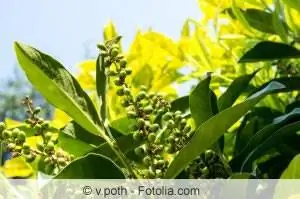
Special fertilization is not required for cherry laurel. A good layer of mulch is completely sufficient for good growth. The hobby gardener should only water the laurel cherry when the soil is completely dry. Otherwise he can cope with the conditions given to him.
Fertilizing when planting
We recommend adding horn shavings to the planting hole when planting. This means the tree has good initial fertilization and lasts for a while. At the beginning of the growth phase, i.e. in spring, the cherry laurel needs additional nutrients in order to get off to a good start. It is best to use a complete fertilizer for trees.
It is important to remember that you do not fertilize for too long. The branches and twigs must be able to mature in order to survive the winter well. If you fertilize for too long, they will continue to grow and not mature. These branches are then very vulnerable to frost. Failure to mature means that the bark needed for protection does not form. That's why the complete fertilizer is only used until July. Then the plant will continue to grow well without it. In principle, it is enough for the cherry laurel if you mix in a lot of compost in the spring. The plants are easy to care for and even require no extra fertilizer.
Autumn fertilization
What you should do is to use potash fertilizer at the end of August or beginning of September to ensure that the cherry laurel survives the winter well. Potash fertilization is suitable for all trees in the garden. The fertilizer helps branches and twigs mature and makes them resistant to disease. The potash fertilizer also helps regulate the fluid balance, so it is more than recommended. Autumn fertilization is much more important than fertilization with complete fertilizer. You can also leave these out. However, potash fertilization helps to survive the winter relatively unscathed.
Propagation and cutting
The cherry laurel can be propagated in two different and quite simple ways. On the one hand, through the so-called lowerers, whereby long shoots are bent down to the ground. Here they are then pinned, covered with a little soil and left to their own devices until a small cutting grows from a so-called eye. If it is large enough to support itself, it can be separated from the mother plant. But general propagation through cuttings is also quite easy. There are enough of these with every pruning. When placed in potting soil, perhaps with a special rooting powder, they usually do well.
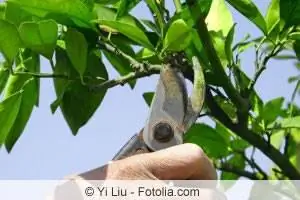
The cherry laurel can be cut back easily and without any major problems. It can be easily cut after it first sprouts in spring. This prevents sprawling and bulky growth. Pruning is best done by hand and without electric tools so that whole leaves are preserved. For older laurel cherries that may have gotten a little out of shape, you can easily cut back into the old wood to give them a rejuvenation treatment.
Winter protection
Since the laurel cherry is a perennial plant that is also evergreen, there is no need for special winter protection. The plants survive the winter temperatures prevailing in our latitudes very well with a sufficient layer of mulch to protect against loss of moisture. Should the winter become more severe and have temperatures of -20 degrees or more, the cherry laurel may completely lose its leaves and some parts of the plant may die. In most cases, however, it sprouts again in spring.
Frequently asked questions
Can a cherry laurel serve as a windbreak?
Hedge plants normally have the ability to slow down the wind. The cherry laurel can tolerate wind, but its structure means that it has grown so densely that the wind cannot penetrate through it. It is directed upwards, so to speak, and therefore forms small turbulences, which can be very unpleasant if there is a seating area directly behind the cherry laurel hedge. In order to create a pure windbreak hedge, it is better to use more suitable plants.
What diseases and pests can occur in cherry laurel?
Cherry laurel is mostly caused by fungal diseases that can occur depending on the location and soil conditions. A humid and warm climate promotes fungal growth, so care should always be taken to ensure that the soil drains well. The first sign of such a fungal disease is spotty leaves. Failure to take action against the disease can result in plant death. A fairly widespread pest is the so-called voracious weevil. This, so to speak, eats its way through the leaves, which then show significant traces. However, early treatment of the cherry laurel with environmentally friendly and biodegradable agents prevents the infestation.

